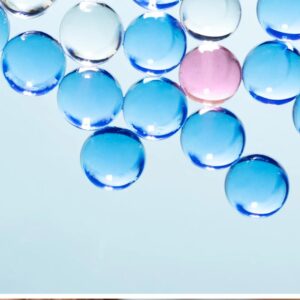Molecular and Cellular Mechanisms of Dynamic Wrinkle Formation by Facial Muscle Activity
 Faramarz Rafie MD / Vancoderm Academy and College (VDA) / Vancoderm Clinic (VDCMed)
Faramarz Rafie MD / Vancoderm Academy and College (VDA) / Vancoderm Clinic (VDCMed)
Dynamic Wrinkles:
Wrinkles that appear on the skin primarily during facial muscle activity, such as frowning, smiling, or squinting. They result from repeated contraction of mimetic muscles, which temporarily fold the overlying skin. Over time, these temporary lines can become permanent due to structural changes in the dermis.
Mechanism of Dynamic Wrinkles Formation
Dynamic wrinkles are lines that appear on the skin primarily during facial expressions and develop over time due to repeated muscle activity. Facial muscles such as the corrugator supercilia (responsible for frown lines) and the orbicularis oculi (responsible for crow’s feet) contract repeatedly during expressions like frowning, squinting, or smiling.
These mimetic muscles insert directly into the dermis rather than bone, enabling the skin to move with each contraction. Each contraction produces mechanical stress on the overlying skin, causing temporary folding and compression of dermal layers, particularly the papillary dermis, which contains fine collagen and elastin fibers, and the reticular dermis, composed of dense collagen bundles.
Repeated folding leads to microtears in collagen and elastin fibers, weakening the dermal extracellular matrix (ECM). Dermal fibroblasts detect this mechanical strain through integrin-mediated mechanotransduction and initially attempt to repair the ECM by synthesizing collagen types I and III, elastin, and glycosaminoglycans (GAGs).
However, chronic mechanical stress, combined with intrinsic aging and UV-induced oxidative stress, triggers fibroblast senescence and upregulates matrix metalloproteinases (MMPs), particularly MMP-1, which degrade collagen fibers. Reactive oxygen species (ROS) generated during repeated contractions further activate transcription factors like AP-1, accelerating ECM breakdown and contributing to dermal thinning.
The cumulative effect of collagen and elastin fragmentation, dermal thinning, and reduced elasticity prevents the skin from fully rebounding after muscle contraction. Over time, these temporary expression lines evolve into permanent dynamic wrinkles, which may eventually progress into static wrinkles visible even when the face is at rest.
Frown lines (glabellar lines) are particularly common for several reasons beyond just repeated muscle contraction.
Frown lines, or glabellar lines, are particularly common due to a combination of anatomical, physiological, and lifestyle factors. The primary muscles responsible for these lines—the corrugator supercilia and procerus muscles—are small but highly active, contracting frequently during expressions such as frowning, concentration, or stress.
Because these are mimetic muscles that insert directly into the dermis, each contraction immediately folds the overlying skin, creating localized mechanical stress. The skin over the glabella is also thinner and has less subcutaneous fat than other facial areas, making it less resilient to repeated folding.
With aging, the production of collagen and elastin declines, further reducing skin elasticity and its ability to recover from repeated contraction. Additional factors such as UV exposure, smoking, dehydration, poor nutrition, and frequent emotional expressions accelerate dermal weakening and exacerbate wrinkle formation.
Imbalanced Mechanical Pressure:
 Imbalanced mechanical pressure also plays a role in the formation of frown lines. When the corrugator supercilia and procerus muscles contract repeatedly, they generate concentrated forces in the glabellar region, creating localized stress on the overlying skin. Unlike areas with thicker dermis or more subcutaneous fat that can better distribute mechanical load, the glabella is thin and rigid, so the repeated muscle contractions produce high focal pressure, which accelerates microtears in collagen and elastin fibers.
Imbalanced mechanical pressure also plays a role in the formation of frown lines. When the corrugator supercilia and procerus muscles contract repeatedly, they generate concentrated forces in the glabellar region, creating localized stress on the overlying skin. Unlike areas with thicker dermis or more subcutaneous fat that can better distribute mechanical load, the glabella is thin and rigid, so the repeated muscle contractions produce high focal pressure, which accelerates microtears in collagen and elastin fibers.
Over time, this uneven mechanical stress, combined with intrinsic aging and reduced dermal elasticity, reinforces the formation of permanent dynamic wrinkles. Habitual expressions or asymmetrical muscle activity can further exacerbate the imbalance, making frown lines deeper or uneven.
Together, these factors explain why frown lines tend to appear earlier and more prominently than wrinkles in other facial regions.
The Appearance and number of frown lines:
The appearance and number of frown lines can vary among individuals due to differences in muscle anatomy, skin properties, and aging. The primary muscles responsible for glabellar lines—the corrugator supercilia, procerus, and depressor supercilia—can differ in size, shape, and attachment points between individuals, resulting in variations in the pattern of skin folds.
In some people, these muscles create two prominent parallel lines, while in others, additional lines may form due to secondary muscle activity or overlapping muscle insertions, producing three or more folds. The thickness, elasticity, and hydration of the skin also influence how the mechanical forces of muscle contraction are transmitted, which can accentuate or blur individual lines. Age-related changes, such as dermal thinning, collagen fragmentation, and loss of skin resilience, further modify the number and depth of lines over time. Habitual expressions, asymmetrical muscle contractions, and external factors like UV exposure or repeated stress can additionally create variations in the pattern and prominence of frown lines across individuals.
Skincare Impacts on Frown lines:
 Frown lines can be minimized through a combination of targeted skincare, gentle facial massage, and healthy lifestyle habits. A daily skincare routine that emphasizes hydration and skin barrier support helps maintain dermal elasticity and resilience. Ingredients such as hyaluronic acid, peptides, niacinamide, and antioxidants can improve skin hydration, stimulate collagen production, and protect against oxidative stress. Regular gentle facial massage over the glabellar region can improve blood circulation, relieve muscle tension, and promote lymphatic drainage, which may reduce the depth of temporary folds. Avoiding excessive repetitive frowning or squinting, maintaining adequate hydration, protecting the skin from UV exposure with sunscreen, and adopting a balanced diet rich in vitamins and antioxidants further support dermal health. While these measures cannot fully prevent the formation of frown lines caused by deep dermal changes or advanced aging, they can delay their progression, soften their appearance, and maintain healthier, more elastic skin over time.
Frown lines can be minimized through a combination of targeted skincare, gentle facial massage, and healthy lifestyle habits. A daily skincare routine that emphasizes hydration and skin barrier support helps maintain dermal elasticity and resilience. Ingredients such as hyaluronic acid, peptides, niacinamide, and antioxidants can improve skin hydration, stimulate collagen production, and protect against oxidative stress. Regular gentle facial massage over the glabellar region can improve blood circulation, relieve muscle tension, and promote lymphatic drainage, which may reduce the depth of temporary folds. Avoiding excessive repetitive frowning or squinting, maintaining adequate hydration, protecting the skin from UV exposure with sunscreen, and adopting a balanced diet rich in vitamins and antioxidants further support dermal health. While these measures cannot fully prevent the formation of frown lines caused by deep dermal changes or advanced aging, they can delay their progression, soften their appearance, and maintain healthier, more elastic skin over time.
We sincerely thank our readers for exploring this detailed insight into dynamic wrinkle formation. At Vancoderm Academy, we take pride in being a leader in medical aesthetics education, offering both Certificate and Diploma programs designed to deliver high-quality, in-depth training. Our programs emphasize practical skills, scientific understanding, and evidence-based techniques, ensuring that our students achieve successful and lasting results in their professional practice. We are committed to nurturing the next generation of skilled medical aesthetics professionals and invite you to join us on this journey toward excellence.
Have an amazing week ahead!

